La storia di Poulsen Roser A/S
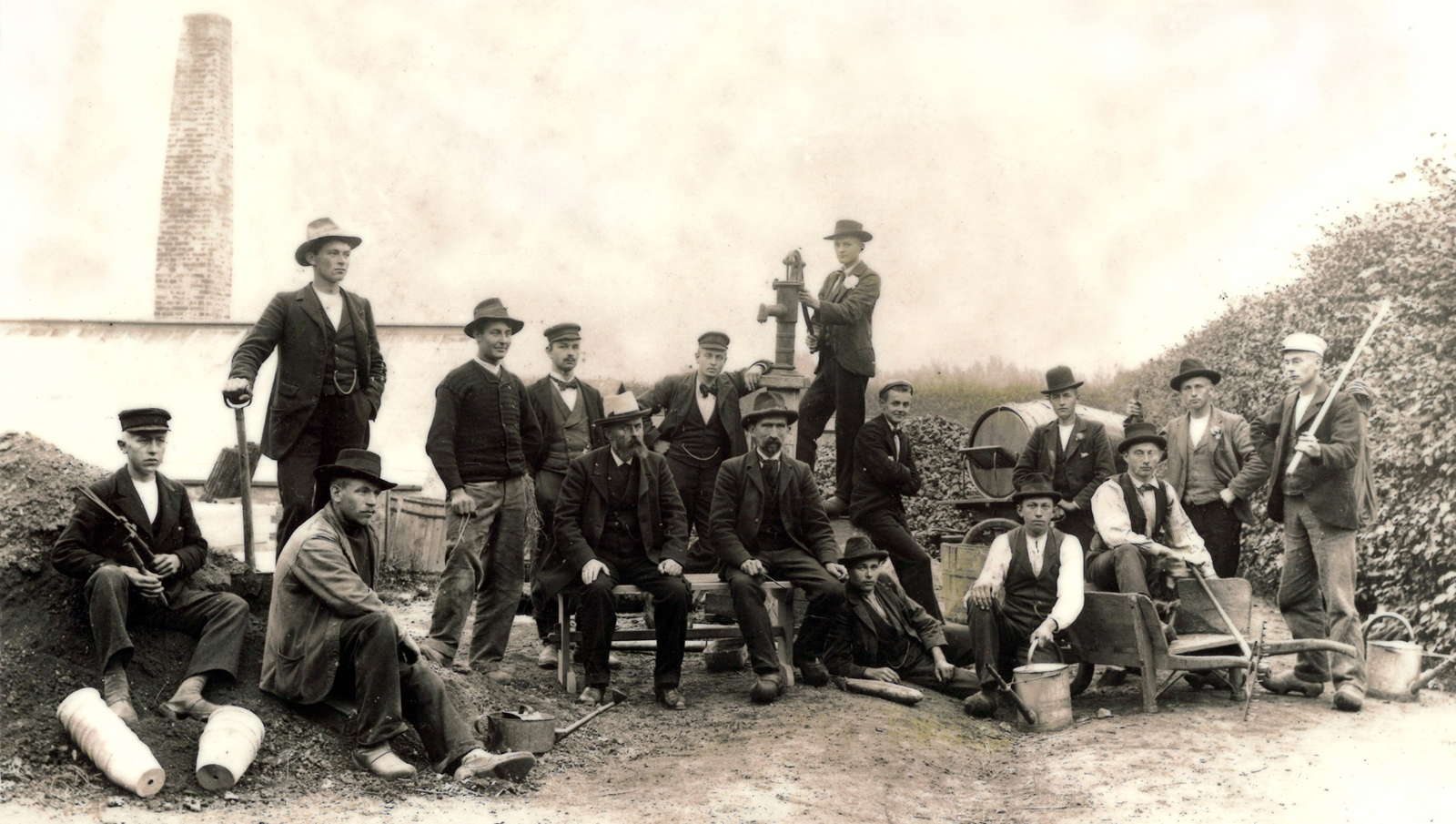
Since the first seeds were sown in Copenhagen in 1878, Poulsen Roser A/S has grown into the world's leading rose breeder. Here's the story behind the stunning flowers, loved by professional gardeners and garden enthusiasts everywhere.
For many generations the Poulsen were a family of farmers and cattle breeders, but on 29 November 1850 Dorus Theus Poulsen was born - and the family tradition was to take a new turn.
Having begun his apprenticeship at the age of 14, he worked at four Danish nurseries. He then studied for three years at The Royal Veterinary and Agricultural College in Copenhagen, passing his examinations in 1872. He continued to study, however, especially abroad. He stayed for two years at E.G. Henderson's in London. In 1874 he was offered a job at the Agricultural College, where we worked for four years. It was during this time that he acquired the "Marielyst" property at Roskildevej 78 in Copenhagen. At that time it was still an agricultural area, not the densely populated urban area it is today.
D.T. Poulsen and his wife Johanne had three sons, all of whom became nurserymen. Dines was born in 1879, Poul André in 1882 and Svend Poulsen in 1884. All of them were to qualify as nurserymen, working during their apprenticeship at nurseries both at home and abroad. Dines worked at one of the top rose nurseries of the time, that of Peter Lambert in Trier, Germany. Peter Lambert was not only the supreme rosebreeder of his age; he also was a talented mentor. His greatest success was Frau Karl Druschki (The Snow Queen). Dines worked under him for almost a year, then moving on to England, where he lived in Stanmore. Here his employer allowed him to carry out cross-breeding in his spare time, as it was clear that Dines had been inspired by the rosebreeding skills of Peter Lambert. When he returned to Denmark he had with him some rose hips that were the result of his first attempts at breeding roses. The seeds were planted in his Roskildevej nursery - and the first two Poulsen roses to be sold outside Denmark were born:
After having been awarded gold medals at the Hamburg exhibition of 1911 these varieties quickly spread throughout most of Europe. Both varieties also rapidly became popular in Scandinavia on account of their extreme robustness. The cross between the mother plants mentioned, a red polyantha rose and a red rose with large blooms, was the forerunner of what later came to be known as the floribunda roses. But even better roses were necessary if roses were to become widely grown in Scandinavia. Robustness and fine blooms were two of the main ideas underlying subsequent Poulsen roses. Dines Poulsen stopped breeding roses, but passed the work on to his brother Svend Poulsen, who launched his first rose 'Luna', a light yellow hybrid tea, in 1918.
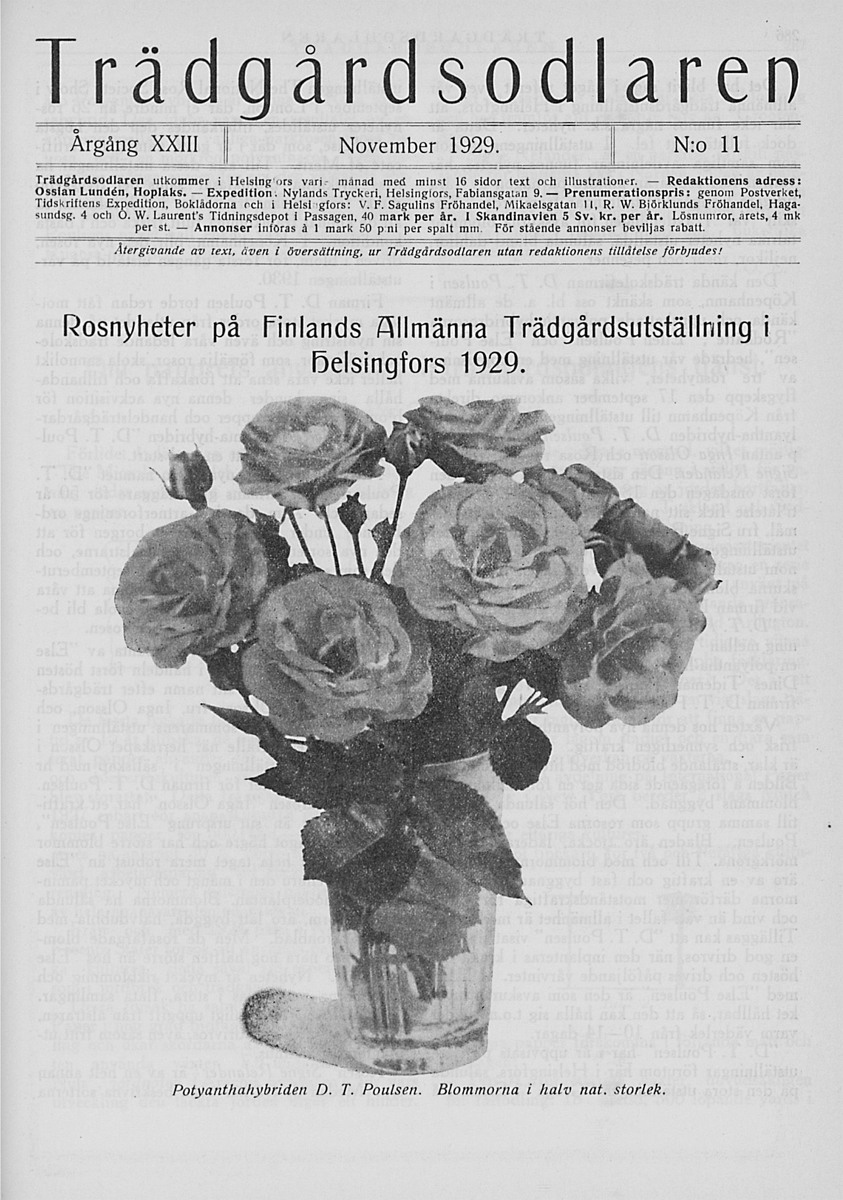 PHOTO: A POULSEN-ROSE ON THE COVER OF A FINNISH GARDENING MAGAZINE IN 1929.
PHOTO: A POULSEN-ROSE ON THE COVER OF A FINNISH GARDENING MAGAZINE IN 1929.
The real breakthrough came in 1923, when 'Else Poulsen' and 'Kirsten Poulsen' came on the market. Both were the result of a cross between 'Orléans Rose' and 'Red Star'. These two new varieties marked the beginning of a completely different type of rose - later called floribunda roses. For many years after having been introduced these types were known by the name of 'POULSEN ROSES'. These roses marked in actual fact a new breakthrough known as Floribunda roses such as we know them today, with many blooms at the same time and optimum robustness and resistance to the rigours of the Scandinavian climate. In 1925 the founder of the business, Dorus Theus Poulsen, died. However, his three sons, Dines, Poul and Svend, carried on his work, with Svend continuing to be responsible for rosebreeding. In 1930 a rose with the name 'D.T. Poulsen' was introduced, named after the founder of the business - a bright red floribunda rose. This was followed by another red variety, 'Karen Poulsen', in 1933, which gained Svend Poulsen his first gold medal at The Royal National Rose Society's rose trials in England.
There had not been many yellow rose varieties until then, but in 1938 the first real yellow variety 'Poulsen's Yellow' came on the scene. This was the first time a yellow Floribunda rose had seen the light of day. It was based on a German variety, 'Gottfried Keller', that had been produced by the German rosebreeder Dr. Frans Müller. In the 1880s he had introduced 'Persian Yellow' into the variety so as to bring yellow blood into modern roses. Unfortunately, Dr. Müller was unsuccessful. However, the genes lay hidden in the variety Svend Poulsen had decided to use in his cross-fertilization work, suddenly resulting in 'Poulsen's Yellow', which extended the palette of the floribunda roses. Svend Poulsen produced a whole series of wonderful roses, such as 'Danish Gold' in 1950 and 'Rumba' and 'Toni Lander' in 1958.
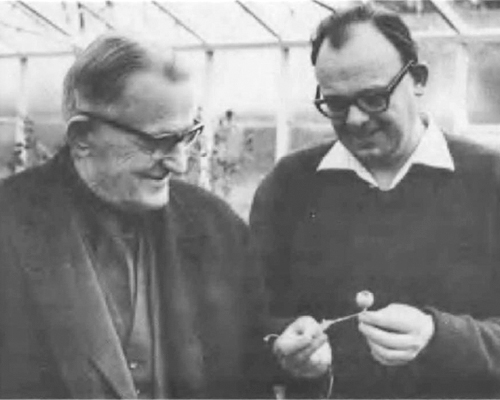 PHOTO: SVEND AND NIELS DINES POULSEN - TWO GENERATIONS IN THE GREENHOUSE.
PHOTO: SVEND AND NIELS DINES POULSEN - TWO GENERATIONS IN THE GREENHOUSE.
In 1954 Niels Dines began to help his father - now with more than 40 years experience - to breed roses.The last of Svend Poulsen's new roses of major international class was NINA WEIBULL®, which was marketed in 1962. A red floribunda rose that was to prove the most cultivated and important red floribunda rose of Northern Europe. Even today it is still extensively cultivated and is possibly still the most popular floribunda variety in Scandinavia.
Svend Poulsen's only son, Niels Dines, was trained at Asger M. Jensen's nursery in Holmstrup and later educated at The Royal Veterinary and Agricultural College in Copenhagen, passing his examinations there in 1943. He then began his work as a nurseryman.
Niels Dines's first result within the field of rosebreeding was 'Chinatown', a yellow, fragrant Floribunda/climbing rose. Overnight the name of Niels Dines was on the lips of those in rosebreeding circles, since 'Chinatown' soon won a considerable number of major international awards. This variety, a robust, sturdy plant, can claim the sweetbriar as one of its distant ancestors. In 1965 'Pernille Poulsen' and 'Western Sun' were introduced, two more examples of Niels Dines's skill as a rosebreeder. Both gained international fame and a great number of excellent results in both Europe and countries overseas.
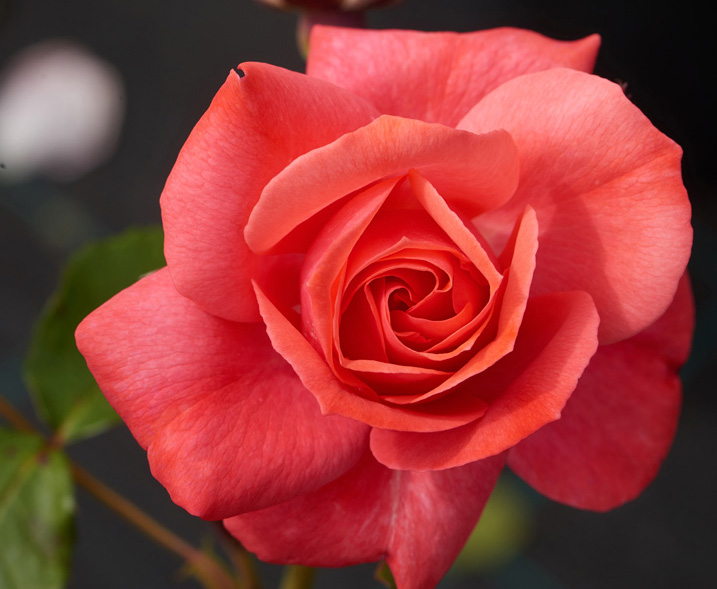
PERNILLE POULSEN™ IS NAMED AFTER NIELS DINES' FIRST DAUGHTER, TODAY CO-CEO IN THE COMPANY.
In 1962 the first Danish legislation on new plants came into force. This made it possible to protect one's own new varieties by having them registered for Breeders Rights. This in turn gave added impetus to rosebreeding. In 1967 the first Poulsen rose suitable for being a cut flower, 'Nordia', was introduced. It quickly found its way to The Netherlands and Israel, where it became widely grown. 'Nordia' was the forerunner of the highly productive Floribundas of the present-day cut flower industry. It has of course since been replaced by improved varieties, but at the time of its appearance it was a real breakthrough. In 1969 'Snowline' appeared, which unfortunately has never become really widely grown in Denmark and the rest of Scandinavia, although it was chosen in 1970 as ADR Rose (Al Deutsche Roseneuheitsprüfung), the highest award given to a rose in Germany.
To produce a worldwide success within the field of roses each and every year is an impossible dream for a rosebreeder. So we have to move on again to 1972 to find the next breakthrough. In that year Niels Dines introduced the large-bloomed, copper-coloured TROIKA® and the dark-red, large-bloomed GISSELFELD™. Epoch-making roses for which the Poulsen breeders as yet are not all that well known, although both varieties have managed to penetrate the Northern European market, since they are specially suited to our extreme climate, with short, wet summers and long, cold winters. Both have gained world-class results, with TROIKA® being awarded The James Mason Gold Medal at the Royal National Rose Society in England in 1992.
A couple of years later, in 1974, Niels Dines introduced 'Shalom', an orange-red shrub rose that has proved very popular in Germany. The final varieties from Niels Dines were 'Nitouche', 'Dolly' and 'Bellevue', all of which have been important for the range of roses found in today's nurseries.In 1987 'Dolly' gained ADR recognition - as did 'Snowline' - the highest award given to a new rose in Germany. And in 1994 Niels Dines Poulsen was awarded the highest acclaim a rosebreeder can aspire to: The Dean Hole Medal, given by The Royal National Rose Society in England.
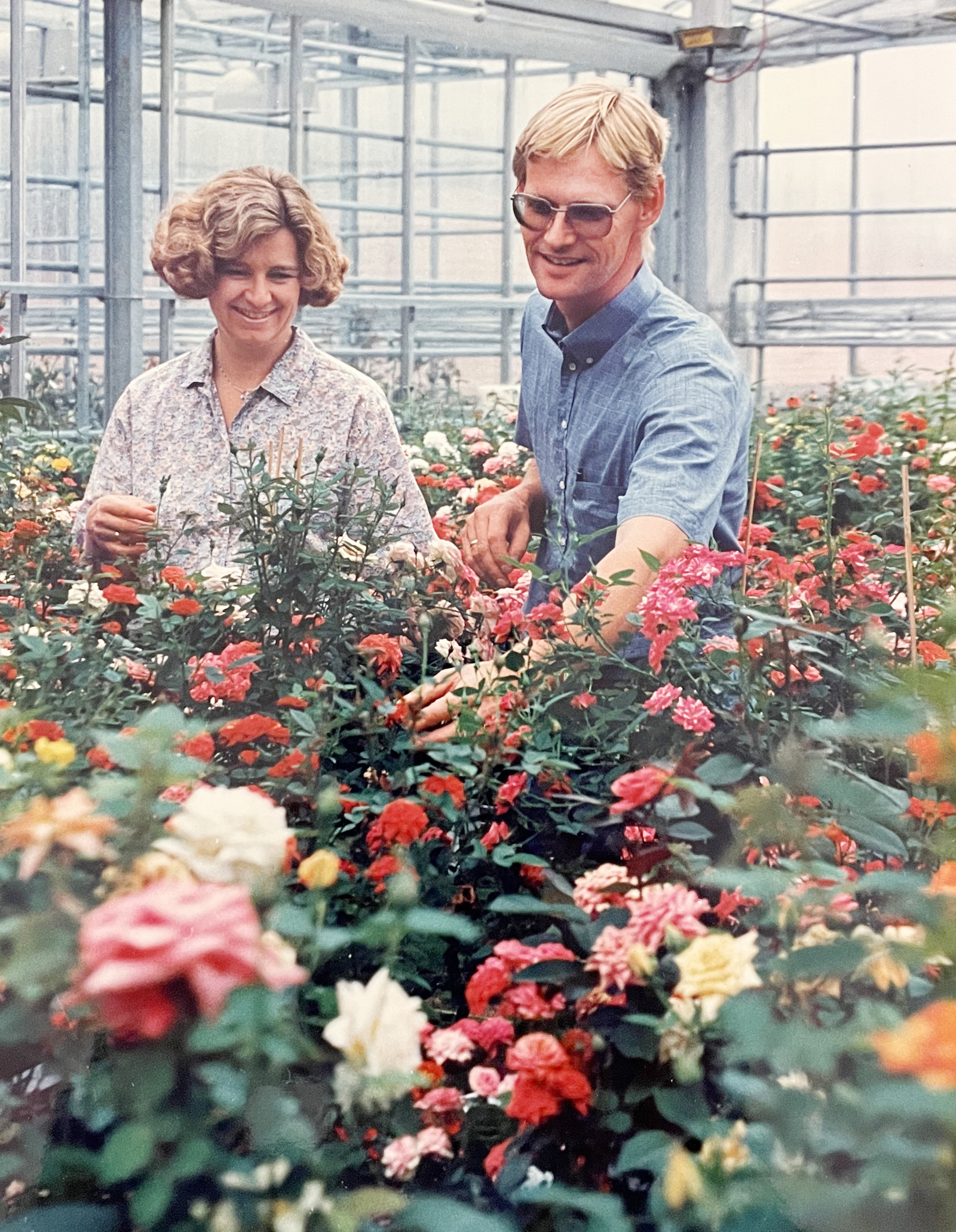 PHOTO: PERNILLE AND MOGENS TOOK OVER THE COMPANY IN 1976 AND HAD GREAT SUCCESS WITH ROSE BREEDING.
PHOTO: PERNILLE AND MOGENS TOOK OVER THE COMPANY IN 1976 AND HAD GREAT SUCCESS WITH ROSE BREEDING.
In 1971 Niels Dines's eldest daughter, Pernille Olesen (née Poulsen), entered the business after having completed her education as a nursery technician. Pernille immediately began to take over responsibility for rosebreeding and the administration work involved. This gave her ample opportunity to gain from her father's experiences, as well as those of her grandfather, Svend Poulsen. In 1976 Pernille and her husband, Mogens N. Olesen, took over the business, where the production and breeding of roses were highly important activities. Mogens came from a family of gardeners - his father Ernst Olesen was a landscape architect and he also ran a nursery himself for a number of years. Mogens had a certain knowledge of nurseries, since his practical training had taken place in one, supplemented by a stay at the nursery of rosebreeder Sam McGredy in Northern Ireland. He completed his education by qualifying as a horticultural graduate at The Royal Veterinary and Agricultural University in Copenhagen in 1973.
In the first few years after 1976 the introduction of new roses was of course a combined effort on the part of Niels Dines, Pernille and Mogens. In 1977 the first Poulsen miniature rose 'Pygmy', a small orange-red miniature variety, appeared, without actually leading to any large-scale production here in Denmark. In connection with the company's 100th Anniversary in 1978 yet another miniature rose, 'Mini-Poul', was introduced. It was later to give rise to a whole series of miniature roses from Pernille and Mogens' rosebreeding activity. New roses appear practically every year, but we have to move on to the year 1980 before Pernille and Mogens' rosebreeding begins to make the big time. A new breakthrough for the Poulsen dynasty's rosebreeding is in sight. PINK BELLS® POULBELLS, RED BELLS® POULRED and WHITE BELLS® POULWHITE are introduced as the first real ground cover roses. Pernille and Mogens had the dream of developing roses that could be used in park gardens and borders like other ground cover plants, such as Cotoneaster.
Worldwide professional interest was aroused by RED BELLS® POULRED being nominated for the highest award for a new rose at the International Rose Trials held in The Hague, The Netherlands, in 1981. The Bells varieties are from a cross between MINI-POUL™ and 'Temple Bells', the former containing the Rosa Luciae and the latter Rosa Wichuriana. Both belong to the shrub roses, with robustness and great strength as their prime features. Unfortunately they lacked robustness in the northernmost parts of Scandinavia, in Norway, Sweden and Finland, where they can survive the severe frost but, since the varieties flower on two-year-old stems, flowering is scanty. They have become very widely grown in Central European countries, however, as well as in England, where they are extremely popular. They are also very easy to grow from cuttings.
Only one year later, in 1981, Pernille and Mogens achieved another result of great international interest within the field of new roses - TEENY WEENY™ was introduced as the first miniature rose suitable for being grown from cuttings and for production as a pot plant. Here too TEENY WEENY™ was the result and the realization of an idea that Pernille and Mogens had from the very outset of their careers as rosebreeders.
After Denmark's entry into the Common Market there was considerable discussion and activity in nursery circles about which areas were to be concentrated on for production. As everyone knows, tremendous emphasis was put on the flowering pot-plant production, a field in which Denmark is now a world-leader. Pernille and Mogens had similar thoughts, working from the start of their career as rosebreeders on developing a miniature rose that was precisely suitable for production as a pot plant. It turned out that their idea of crossing one of the new seedlings with the earliest rose of the Poulsen dynasty, 'Harriet Poulsen', gave the desired result - a combination of luxuriance, vitality and a profusion of blooms, all drawing on qualities from the parent varieties. TEENY WEENY™ was, to begin with, the most popular variety for miniature rose production.
The TEENY WEENY™ rose was the first Parade®-Rose. Today PARADE® roses are known throughout the world as the market's best pot rose. Pernille and Mogens succeeded in creating a genuine pot plant rose. Unlike the innumerable miniature roses that are simply grown in a pot, this was a truly harmonious pot rose, with a pleasing array of blooms at the top of the plant, above good, healthy foliage and a strong root system. All PARADE® roses are fully able to withstand the Scandinavian climate, as the new varieties have all been tested outdoors along with the garden varieties.
When TEENY WEENY™ came onto the market in 1981, Danish production of pot roses stood at around a few hundred thousand a year. However, since then there has been rapid development, with several foreign varieties also coming into production. Despite this, Pernille and Mogens were convinced that if pot roses were really going to be a pot plant product, the life of the individual blooms as well as of the plant as a whole would have to be considerably improved. In the years immediately after 1981 Pernille and Mogens did not introduce any more PARADE® roses, as they were busy trying to improve the life of the roses by further breeding.
In 1984 Pernille & Mogens decided to start a new company only being occupied by plant breeding. So Poulsen Roser A/S in its today form began. More efforts were thus given to conduct only rose and clematis breeding, which later has been proven to be the right choice as the company has become probably the most successful rose and clematis breeding company in the world in the last 40 years. More effort where given to breeding and the development of pot rose varieties.
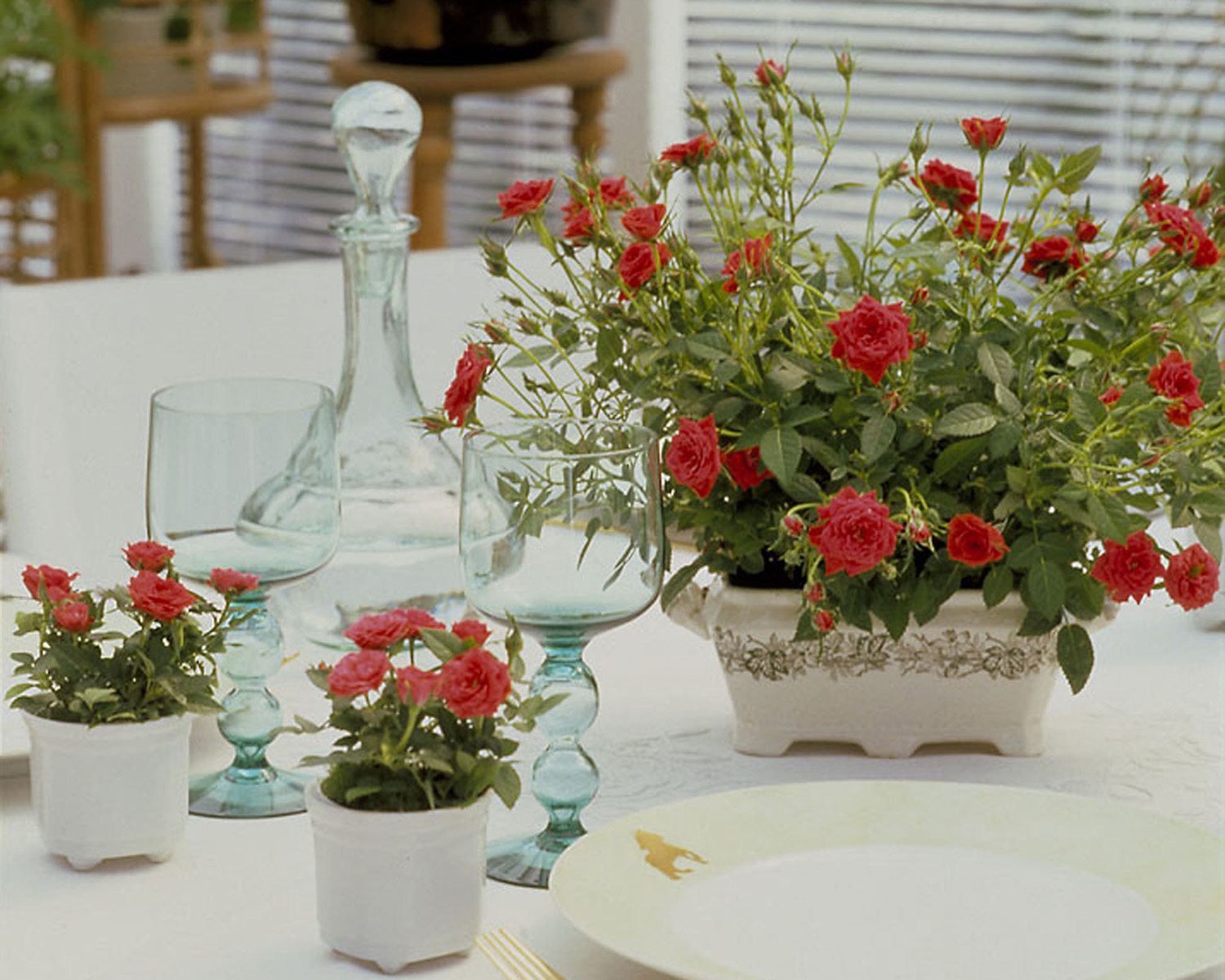 PHOTO: THE MINIATURE POT-ROSE 'VICTORY® PARADE®' FROM 1987 HAS LIVED UP TO ITS NAME.
PHOTO: THE MINIATURE POT-ROSE 'VICTORY® PARADE®' FROM 1987 HAS LIVED UP TO ITS NAME.
The great breakthrough came in 1986, when PINK PARADE® POULCAR came onto the market. It had all the qualities one could dream of for a good PARADE® pot rose. Yet only a year later Pernille and Mogens followed it up with a further variety that was to be a trailblazer for all of European pot-rose production - VICTORY® PARADE® POULVICⓃ. This was the first pot rose that really met the requirements for long life demanded by transportation, point-of-sale and the consumer. Since coming onto the market in 1987 it has been the top variety, not only in Danish production but internationally.
PARADE® pot roses have made their mark throughout the world, with rapid expansion now taking place in North America, Japan and other important countries. The latest PARADE® rose, CHARMING PARADE® POULHAPPYⓃ introduced in 1994 - more than 10 years after the first PARADE® rose came onto the market - seems to point to the fact that the lifespan of the pot rose as regards transportation, point-of-sale and matching consumer wishes has once more taken a great leap forward, since this rose has demonstrated that a single bloom can last for up to four weeks. So there is much to suggest that the fairy-tale story of PARADE® pot roses will continue for many years to come.
Pernille and Mogens are deeply interested in garden roses as well as pot roses. In 1982 the next sensation arrived on the scene - EGESKOV™. This is a cross between 'Tornado' and 'Matangi', which accounts for its great robustness and vitality since both roses are strains of the 'Marlena' rose, relating them back to 'Lili Marleen'. EGESKOV™ received the Golden Rose award in Belgium in 1980 and took first prize in Copenhagen the year after. During the harsh winters of 1984, 1985 and 1986 it proved itself to be one of the hardiest garden roses. It is, however, also a magnificent rose for warmer climates and is found in many countries throughout the world - sometimes under the name 'Rosehill', as it has a host of long lasting blooms with the traditional pink colour.
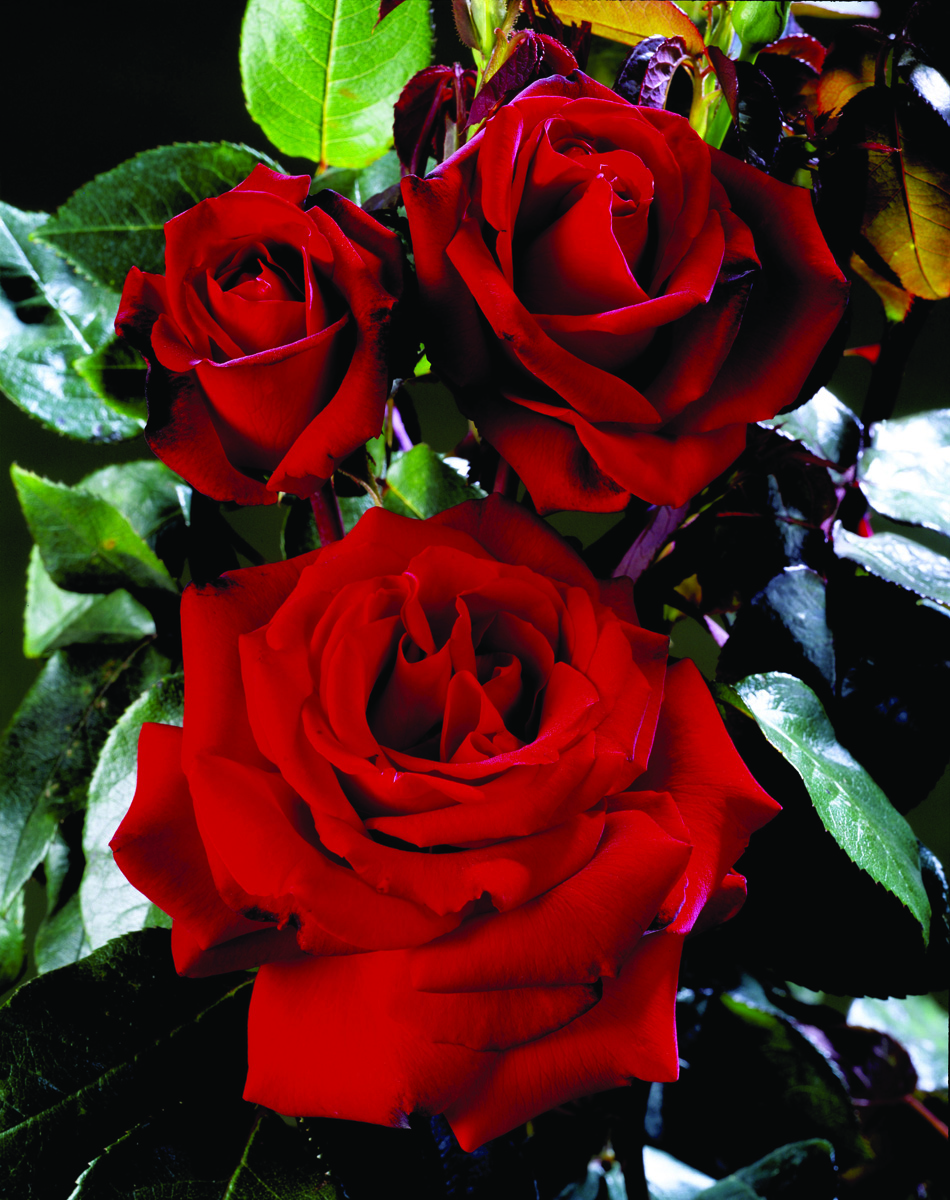 PHOTO: INSCRIBED IN THE "HALL OF FAME" AS ONE OF THE WORLD'S VERY BEST: 'INGRID BERGMAN®' CREATED BY POULSEN ROSER.
PHOTO: INSCRIBED IN THE "HALL OF FAME" AS ONE OF THE WORLD'S VERY BEST: 'INGRID BERGMAN®' CREATED BY POULSEN ROSER.
And then in 1983 came the rose all rosebreeders dream of developing - the crimson-velvet INGRID BERGMAN® POULMAN opened its petals. Practically all the good qualities acquired over the years by Poulsen roses are gathered together in this superb, dark-red rose with large blooms. Varieties such as TROIKA® and GISSELFELD™ are present on one side, with 'Precious Platinum' on the other. 'Precious Platinum' is without a doubt responsible for the great luxuriance and willingness to blossom found in INGRID BERGMAN® POULMAN, while TROIKA® and GISSELFELD™ have given it robustness, intense colour and intriguing fragrance. The variety has won a host of international awards and is now sold throughout the world. In countries as far away as New Zealand and South Africa it has been singled out as Rose of the Year, and it is also widely grown in Europe. It can boast more than 22 medals, of which is also 'Hall of Fame' and the 'Golden Rose of the Hague'.
In 1984 the new PATIOHIT® roses - TEXAST POULTEX and EVITAT POULVITA - were introduced - a modern type of polyantha rose. The introduction of these two varieties has shown itself to be as great a breakthrough as the PARADE® roses. Pernille and Mogens' PATIOHIT® roses are further proof of the fact that dedicated rosebreeding produces results. The PATIOHIT® roses are a kind of 'missing link' between miniature roses, PARADE® roses and polyantha hhybrids - Mother's Day roses. After PARADE® roses, PATIOHIT® roses are the most rapidly expanding culture in the European market. They are produced in 12 -13 cm pots and are true roses as regards buds and foliage. This type of rose really makes an impact when SUN HIT® POULSUNⓃ was introduced in 1988. Then come PERFECT HIT® POULFECT, VIOLET HIT® POULTINⓃ and - the latest additions - the dark-red FANTASY HIT® POULDYB and ABSOLUTE HIT® POULROUGEⓃ, which in 1994 are the PATIOHIT® varieties most in demand. Over the past 6-7 years the production of PATIOHIT® roses has developed from a small share of the total pot rose market to a very important culture. In 1994 way over 100,000 PATIOHIT® roses are being produced each week in European pot-rose nurseries. The varieties are extremely versatile, being suitable not only as gifts but also for direct planting in the garden. All pot roses, be they PARADE® or PATIOHIT®, have been thoroughly tested outdoors during research work carried out at Poulsen Roser's in Fredensborg. No matter what use they are to be put to, robustness and vitality are demands which have to be met. In 1996 the miniature roses were introduced as the product line PARTY®. This collection has been very popular in recent years and at the moment the full colour spectrum is produced.
In 1986 the dark-red, velvety polyantha H.C. ANDERSEN® POULANDER was introduced. The idea behind this rose was to create a fast-growing, healthy, extremely robust variety which in the long term could become a modernized version of the Floribunda NINA WEIBULL®. The crossing of 'Gruss am Bayern' with 'Royal Occasion' produced this desired combination. This rose has already gained a Certificate of Merit in New Zealand and in Orléans, France, as well as a silver medal in Belgium. It has proved itself to be extremely hardy, having been tested during the severe winters of 1984, 1985 and 1986 high up in Central Sweden, where it survived the winters without any problems whatsoever. H.C. ANDERSEN® POULANDER has become a real Scandinavian rose, well-suited to our harsh climate.
During 1988 and 1989 the development of the TOWNE & COUNTRY® roses, of which PINK BELLS™, POULBELLS, RED BELLS™ POULRED and WHITE BELLS™ POULWHITE were forerunners, continued. Here too it was necessary to think along non-traditional lines. Pernille and Mogens realized that if TOWNE & COUNTRY® roses - as they are normally referred to, although shrub roses for landscaping is perhaps a better term - were to be developed, continuous blooming was a must. At the same time they would have to be robust and have more blooms than the first varieties. The introduction of PINK COVER® POULNOZ and WHITE COVER® (KENT®)POULCOVⓃ in 1989 marked just as great a breakthrough as had previously been seen in the field of pot roses. Both varieties, but WHITE COVER® (KENT®) POULCOVⓃ in particular, are - genetically speaking - something of a sensation. In just its 3rd to 4th generation the variety contains no fewer than three strains of rose: 'Rosa Sinensis' and 'Rosa Multiflora' on the one side, and 'Rosa Wichuriana' on the other. The variety is unique, since it blooms continuously, is extremely hardy and, as a healthy shrub, reaches a height of around 80 cm when fully grown. WHITE COVER® (KENT®)POULCOVⓃ is the rose that has gained the most international results to date in the company's 116-year history when it comes to gold medals and prizes.
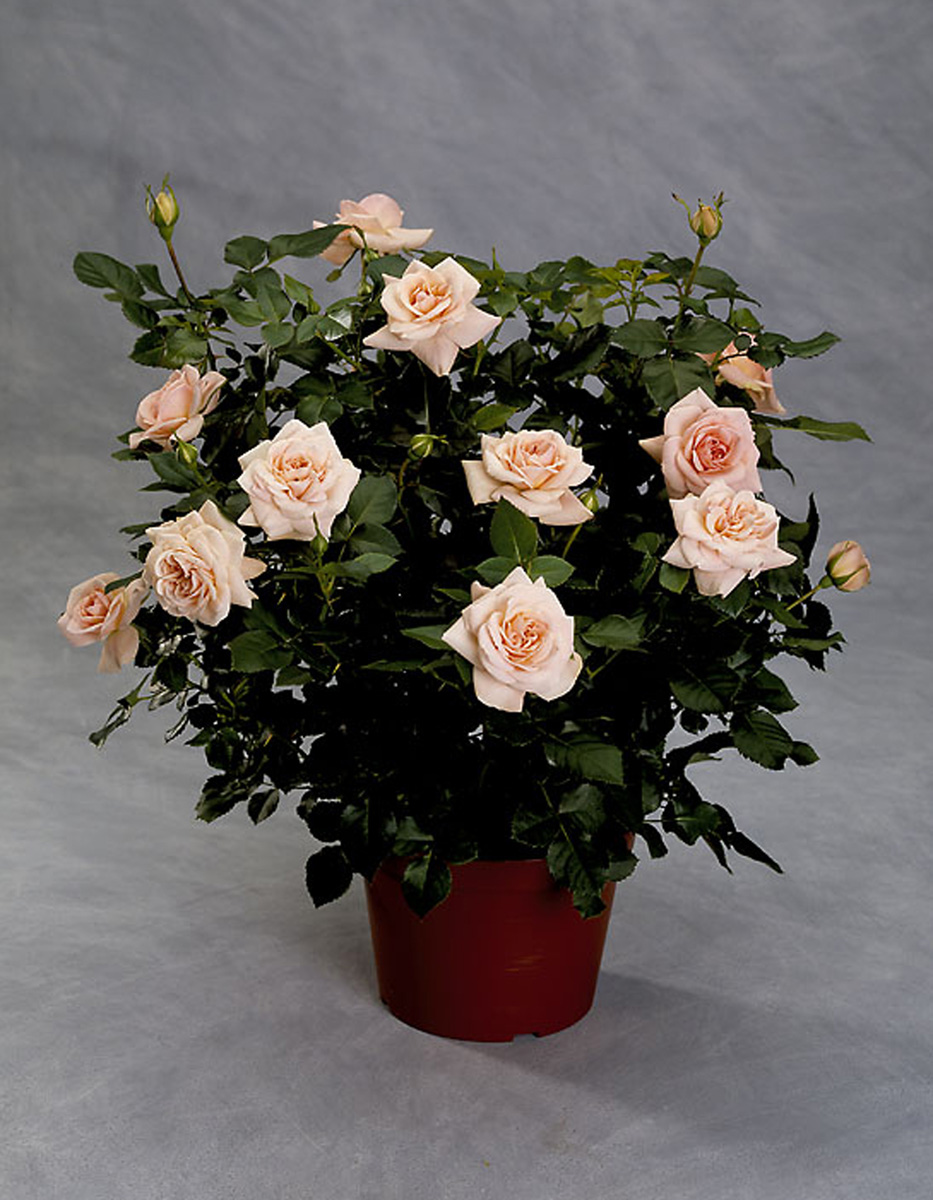 PHOTO: THE DANISH QUEEN MARGRETHE NAMED HER OWN PALACE® ROSE FOR HER 50TH BIRTHDAY IN 1994..
PHOTO: THE DANISH QUEEN MARGRETHE NAMED HER OWN PALACE® ROSE FOR HER 50TH BIRTHDAY IN 1994..
The development of new rose varieties thanks to the creative, dedicated work of Pernille and Mogens throughout their careers as rosebreeders resulted in yet another international breakthrough on the rose market in 1993. PALACE® roses are the name of a new type of short, shrub like polyantha rose introduced at the plant exhibition Plantarium '93 held in Boskop in The Netherlands in August 1993. The prototype for PALACE® roses is DRONNING MARGRETHE™ POULSKOV, a rose launched for the Danish Queen Margrethe II's 50th birthday in April 1990. It took a few more years to develop this new, unique type of rose, which Pernille and Mogens consider to be the garden rose of the future. These varieties, like PARADE® -, PATIOHIT®,- and TOWNE & COUNTRY® roses can be grown from cuttings and can then be produced in 2 or 3 litre containers outdoors, resulting in blooming container items that open up the opportunity of selling the roses for planting out while in full flower.
At the presentation ceremony at the Boskop exhibition Pernille and Mogens were given the top award, since this type of rose was - and is - something quite special: a new culture and production form for garden roses. For the most part production takes place in greenhouses to begin with. After this first phase production continues outdoors on rolling benches - a great innovation within the production of nursery plants is in sight.
In 1993 DRONNING MARGRETHE™ POULSKOVⓃ was already on the market and further varieties were introduced: TOPKAPI PALACE® POULTHEⓃ (pink), HAMPTON PALACE® POULGRETⓃ (white), CRYSTAL PALACE® POULREKⓃ (delicate peach) and IMPERIAL PALACE® POULCHRISⓃ (dark red). These roses have the shape of the traditional 'Tudor rose', with a quartered centre, full blooms and a gentle fragrance reminiscent of a wild rose. No doubt PALACE® roses will gain in importance in the traditional rose market. They are an important step towards producing roses as cuttings using a modern, efficient form of production - one that takes account of technical advances, customer requirements and potential development.
New technology has resulted in the development of garden roses of revolutionary characteristics - they can be propagated by cuttings. These new varieties of garden roses - PALACE®, RENAISSANCE®, TOWNE & COUNTRY®, CASTLE®, COURTYARD®, PARAMOUNT® and NATIONAL PARKS® are something quite special, comprising a new way of culturing and producing garden roses. Production during the first culture period is by cuttings in the greenhouses with the roses growing to maturity outdoors. Propagation by cuttings marks a revolutionary advance in the production of garden roses, which until quite recently could only take place using the budding of eyes on rose understocks.
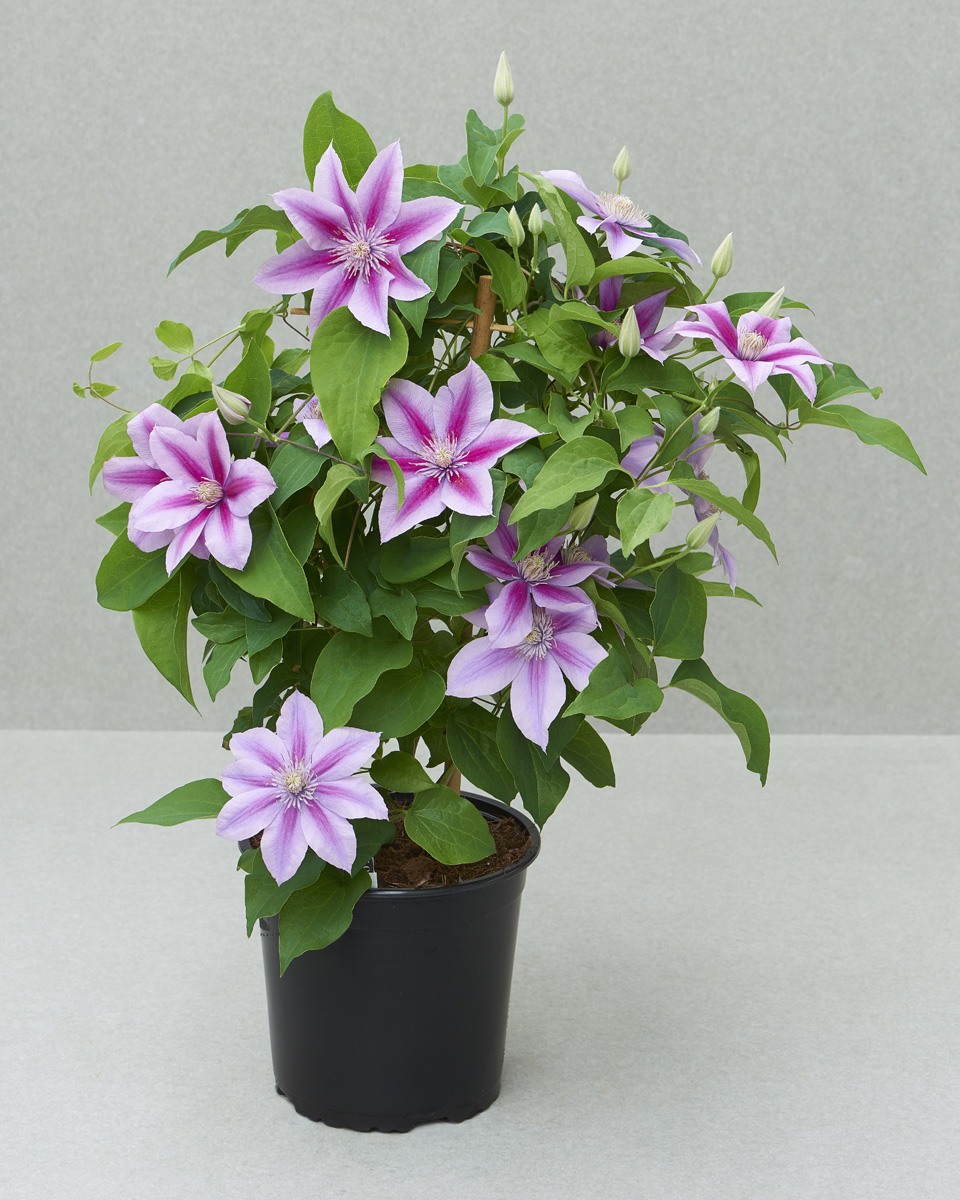 PHOTO: POSEIDON™ IS ONE OF THE MANY UNIQUE POULSEN CLEMATIS SOLD WORLDWIDE.
PHOTO: POSEIDON™ IS ONE OF THE MANY UNIQUE POULSEN CLEMATIS SOLD WORLDWIDE.
Since 1994 when Poulsen Roser included the breeding of clematis in our programme, we have developed a large variety of these amazing plants.
The clematis are spectacular because they are produced for planting in pots indoors and outdoors. The colours and shapes of these clematis are very unusual and the demand for these varieties keep increasing. Every year several new clematis varieties are being introduced, and the production under license continues to expand. At the moment more than two million clematis are being sold annually all over the world.
In 1994 Pernille and Mogens N. Olesen bought a wine castle, the Château Lecusse, in the Gaillac district of France, where they every year produce 450.000 bottles of wines. The château has been totally modernised so that the wine production is taking place on the optimum conditions. Consequently, consumers are offered excellent wines.
During time, Poulsen Roser has received a large number of international awards. 1994 has broken the record with 75 awards, where 25 were gold. The year started with a gold medal and silver medal at the rose trials in Genoa, Italy, for the white HT KAREN BLIVEN™ POULARIⓃ and GENTLE COVER® POULLENⓃ It has also just received a special award for Most Novel Rose in Palmerston, New Zealand, for its GENTLE COVER® POULLENⓃ, seen as marking a striking new development within the field of shrub roses. In 2008 Poulsen Roser received 42 medals for outstanding varieties and unique rose breeding. Top prize winner this year was the PARAMOUNT® rose FABULOUS™ Poulpmt007Ⓝ and the RENAISSANCE® rose GHITA™ Poulren013Ⓝ for their magnificent fragrance.
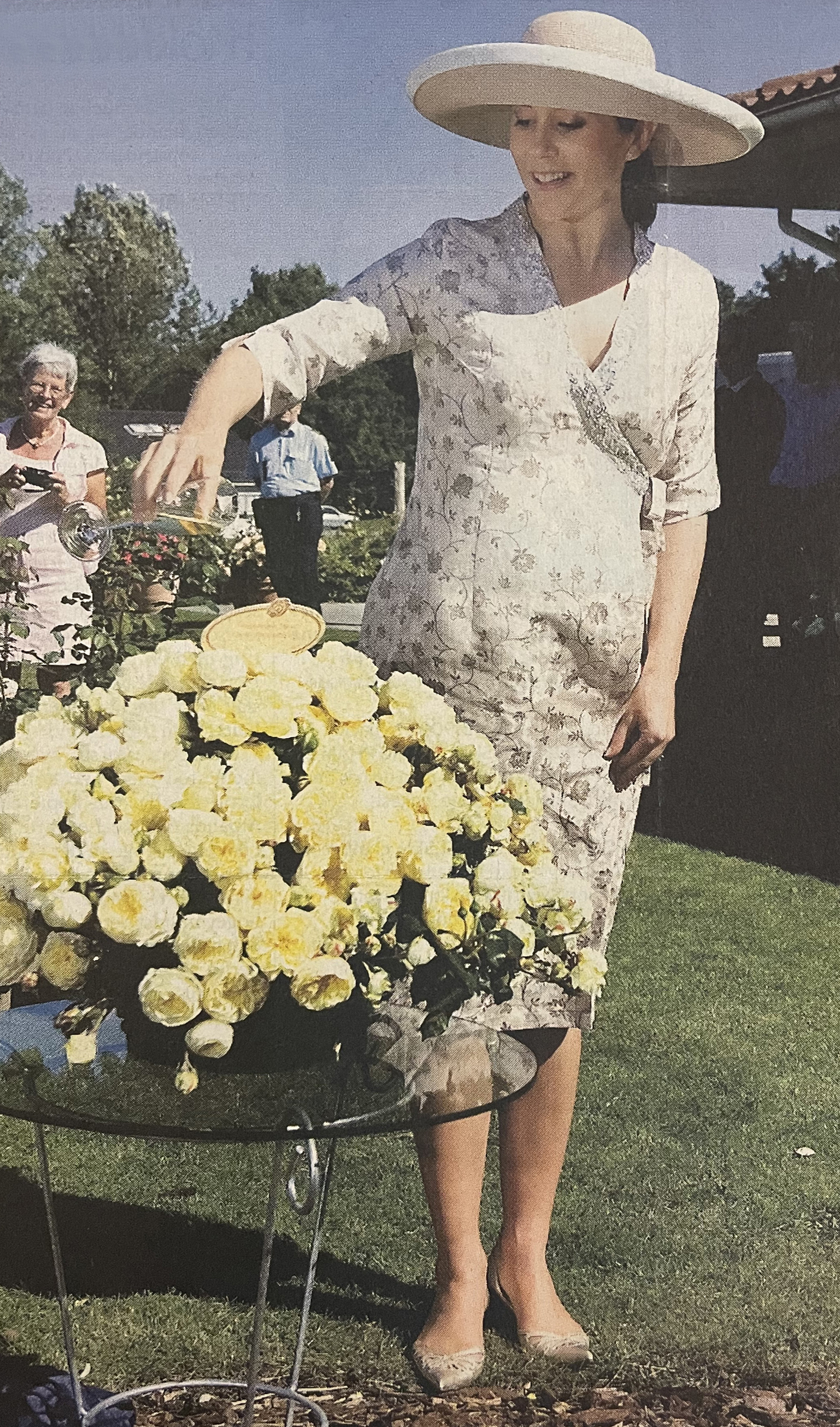 PHOTO: QUEEN MARY BAPTIZED HER OWN CASTLE® ROSE AS CROWN PRINCESS IN 2005.
PHOTO: QUEEN MARY BAPTIZED HER OWN CASTLE® ROSE AS CROWN PRINCESS IN 2005.
Poulsen Roser A/S holds the title "By Appointment to The Royal Danish Court". In 1998 the RENAISSANCE® rose PRINCESS ALEXANDRA™ POULDRAⓃ was introduced and baptized by the former H.R.H. Princess Alexandra now Countess Alexandra and in 2005. the CASTLE® rose KRONPRINSESSE ™ POULCAS018Ⓝ was introduced and baptized by Her Royal Highness Crownprinsess Mary
In 2008 Pernille and Mogens started a new venture as they bought a game farm in South Africa, where they breed and raise wild animals, such as rhinos, giraffes, buffalos, black Impalas, golden gnus and a large number of african gazelles. The game farm produces wild animals that are being sold to other game farms and Zoos around the world, all for the purpose of preserving the exotic wild animals of Africa.
Poulsen Roser A/S has been run as a highly efficient breeding organization since being taken over by Pernille and Mogens in 1984. No finished plants are sold from the nursery, only licences for production are marketed. Today the company licenses annually about 30 million roses and 2 mill clematis on licence worldwide. Poulsen Roses are sold in more than 60 countries and more than 40% of all pot roses sold worldwide are Poulsen Roses. All Poulsen roses and clematis can be grown from cuttings and all of them with the same resistance and hardiness as if they where budded or grafted. In its self a revolution of the production methods for roses.
Every year Poulsen Roser A/S introduces more than 30 new and improved varieties of roses and clematis. Besides the sheer beauty of the roses and clematis, fragrance, hardiness, resistance and keeping quality are the keywords for the future breeding of the company. Poulsen Roser A/S continues the expansion of the rose empire.
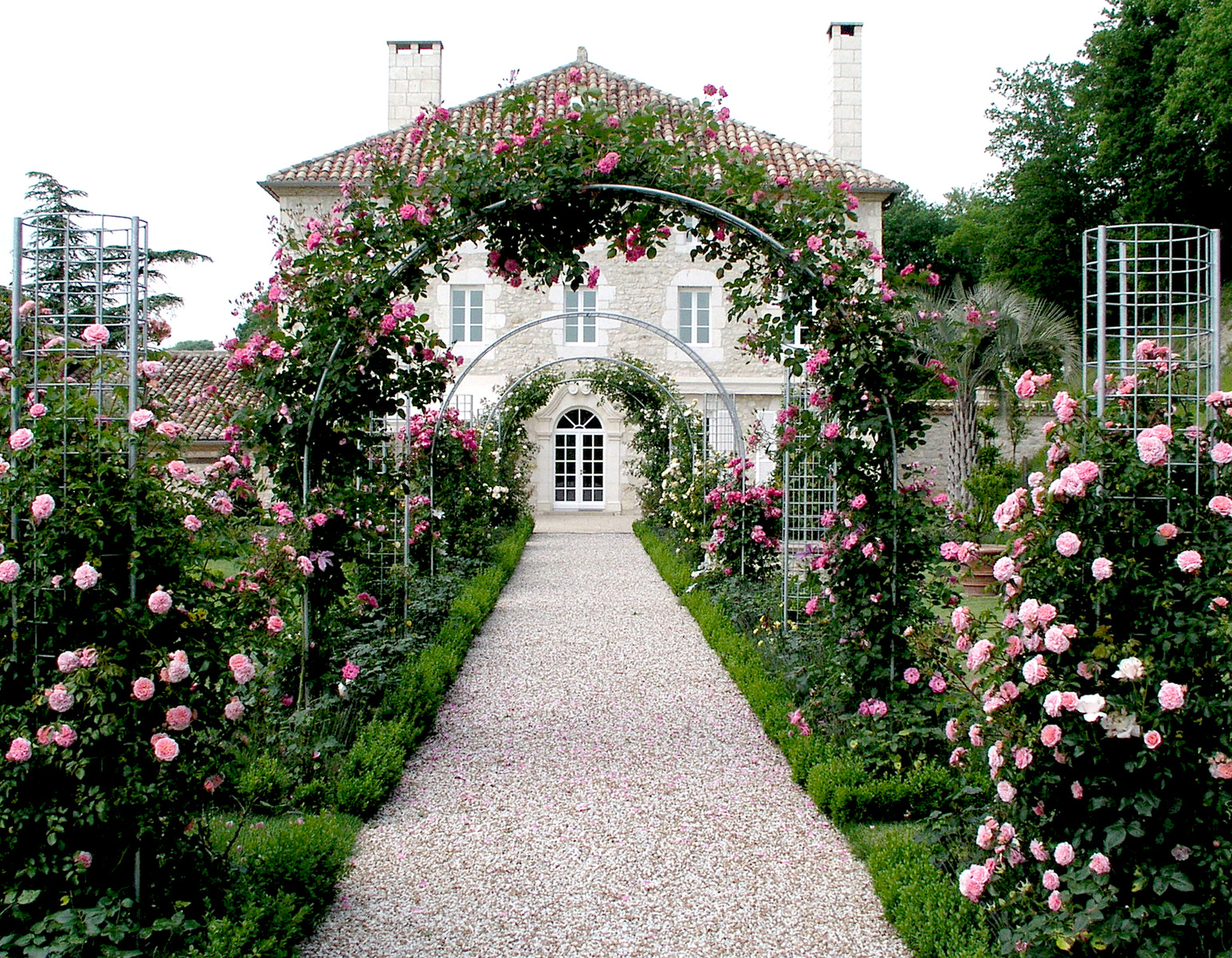 PHOTO: CHATEAU LECUSSE WELCOMES EVERYONE WHO LOVES WONDERFUL WINE - AND BEAUTIFUL ROSES.
PHOTO: CHATEAU LECUSSE WELCOMES EVERYONE WHO LOVES WONDERFUL WINE - AND BEAUTIFUL ROSES.
